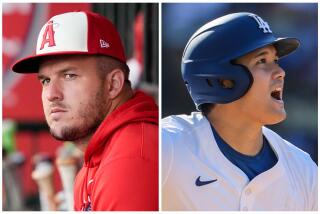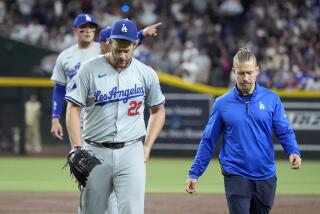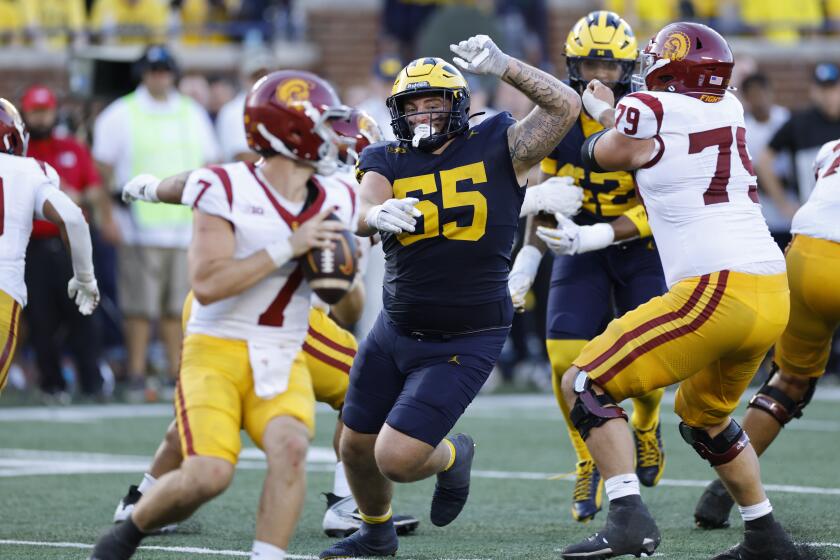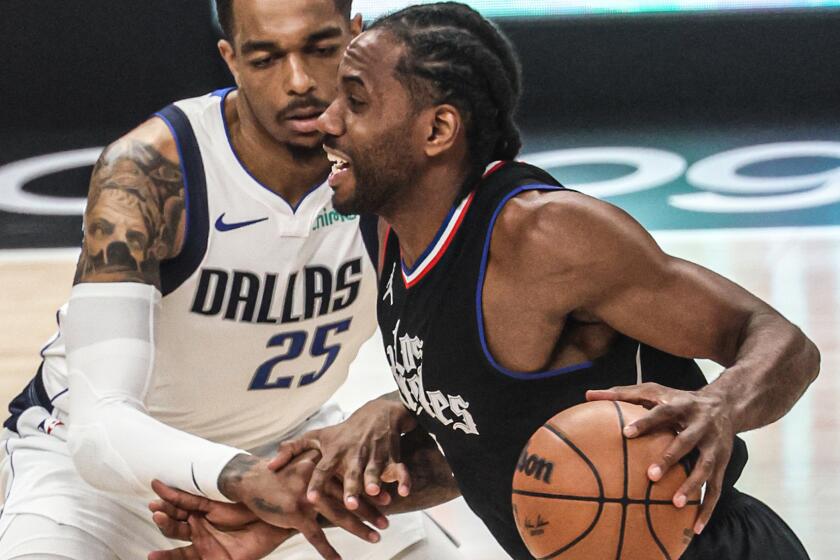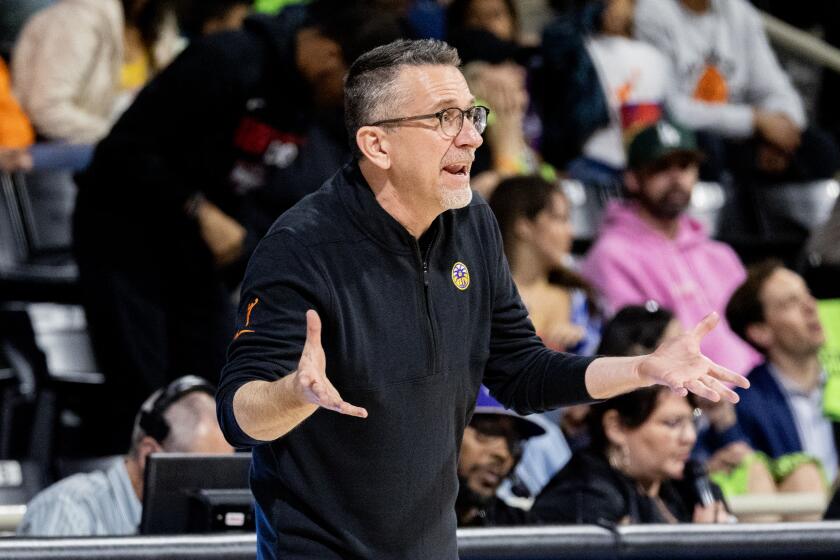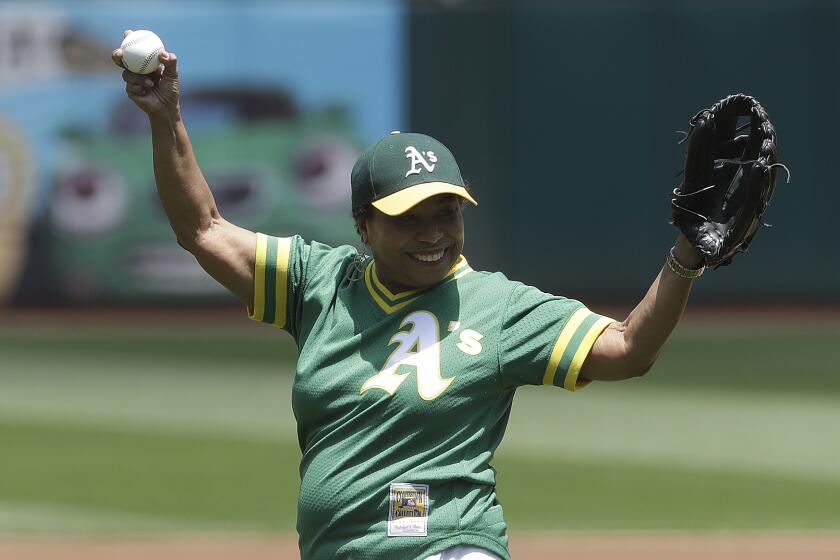Promised Land
Moses Malone once stood in LeBron James’ shoes -- only he wasn’t paid $90 million to wear them.
Malone, one of the best rebounders in the history of the NBA and a member of the basketball Hall of Fame, was one of the first players to take the step James will complete in tonight’s NBA draft, bypassing college to travel from high school straight to the pros.
James, the 18-year-old who just finished his senior season at St. Vincent-St. Mary High in Akron, Ohio, is the most celebrated. By the time his name is announced as the Cleveland Cavaliers’ choice with the first pick in the draft -- only the second high school player to be drafted No. 1 overall, after Kwame Brown in 2001 -- he already will have graced the cover of Sports Illustrated, played several nationally televised games and signed the richest shoe contract ever with Nike.
Malone awaits at the other end of the road now, having established the standard for success that all prep draftees should strive to meet.
But back in his rookie year with the ABA’s Utah Stars in the 1974-75 season, fresh out of Petersburg High in Virginia, Malone was not an NBA champion. He was not a three-time most valuable player. He was not one of the 50 greatest players in NBA history.
“I was homesick,” Malone said.
This isn’t merely leaving the nest to land on a nearby branch. It’s entering a new forest of challenges and experiences thrown at you without any preparation.
“Lifestyle, mental toughness, different type of players,” Malone said. “High school is a different game, because everybody isn’t stronger than you.”
Malone averaged 18.8 points and 14.6 rebounds as a rookie, yet he still felt worn out playing in 83 games.
“In high school, I played like 25 games,” Malone said. “I was homesick my first year. Once you get through that first year and you get through all your games, then you know how all these guys played. Then you know what you’ve gotta do.”
And that’s the lesson from two decades’ worth of high school players who went straight to the NBA. From Malone to Kevin Garnett of the Minnesota Timberwolves to the newly crowned rookie of the year, Amare Stoudemire of the Phoenix Suns, the common refrain is that the NBA is something to be experienced, not talked about.
“We can give [James] all the advice in the world, but he’s going to get it firsthand,” Garnett said. “Believe that.”
After Malone, Darryl Dawkins and Bill Willoughby made the leap to the pros in the early 1970s, it would be 20 years until another high school player was drafted. That was Garnett, from Chicago’s Farragut Academy, with the fifth pick by the Timberwolves in 1995. Kobe Bryant (Lower Merion High in suburban Philadelphia) and Jermaine O’Neal (Eau Claire High in South Carolina) followed the next year. Fourteen more high school players have been drafted since.
It took Stoudemire a month to start registering under an alias at hotels, and to keep a watchful eye on the people in the lobbies.
Brown, the No. 1 overall pick by the Washington Wizards from Georgia’s Glynn Academy in 2001, discovered a way to find fellow teenagers on the road: Ask the hotel concierge the directions to the nearest Dave & Buster’s.
“The league is a thing where you’ve got to feel your way through it,” Garnett said. “No one can prepare you. You talk to a lot of different guys but it’s on-the-job training. Until you live it, it’s totally different.
“I learned how to be more ambitious. I learned how to be confident. I learned how to believe in others. But I also understood that no one wants it for you. You’ve got to want it for yourself. That’s probably the biggest thing. You’ve got to want it for yourself.”
But how many people will want a part of James? One possible pitfall of his selection by the Cavaliers is that it might be impossible to escape all of his hometown hangers-on.
“Entourages get broken down as you go,” Garnett said. “It gets smaller and smaller. You have a group of people that you trust. As you go, the [other ] people are exposed. The ones that have agendas are exposed. If you’re smart, you let them go. It usually works itself out at the end.”
Bryant, the son of former professional basketball player Joe Bryant, wanted the NBA and all that came with it from an early age. It was “pure coincidence,” he said, that he came into the league a year after Garnett. Just a matter of birth dates.
From the first time he wore his Laker uniform, Bryant acted as if he were wearing a three-piece suit. After games, when his older teammates prepared for a night on the town, Bryant could be seen leaving the Forum with videotapes of that night’s game or upcoming opponents in his hand.
“You realize this is your profession,” Bryant said. “This is your job. This is what you want to do. So you be professional about it. You do it to the best of your ability. It’s not about going out and partying, this, that and the other. You’re a working man. Be a professional.
“[College students] get to duck responsibility for four years. [We] get thrust into a situation -- by choice -- where you’re a responsible individual, you pay bills, you manage your money, stuff like that.”
Like Bryant, Brown decided the best way to stay out of trouble was to stay out of the nightclubs. But it frustrated the Wizards that he didn’t devote that time to improving his game. As soon as the last whistle blew at practice, he was back to the room to throw touchdowns or blast bad guys on PlayStation. That made him the target of verbal smack-downs from teammate Michael Jordan and Coach Doug Collins.
Collins thought he had an idea of what he was getting when he and Jordan drafted Brown. Collins hosted Dawkins for three months when Dawkins was the Philadelphia 76ers’ first-round draft choice out of high school, giving Collins up-close access to Dawkins’ own little world.
“I was the only white guy allowed on Planet Lovetron,” Collins said.
In some ways, Dawkins, Malone and Willoughby had it easier than Brown and James.
“It was totally different then, the media scrutiny,” Collins said. “The NBA wasn’t as followed then. You didn’t have the DirecTV where you could watch every game. You didn’t have four or five newspapers covering you. You didn’t have the NBA channel on TV. You didn’t have ‘SportsCenter.’ There wasn’t the scrutiny. You could be more of a young person then. I think it’s getting tougher and tougher to be young now.
“Certain guys are better equipped to handle it. The interesting thing to me about sports is, when you’re really trying to make it, you have to accept the fact that unless you’re out of the norm, you’re going to get your knocks. You’re going to get challenged. You’re going to have some failure. And how do you deal with that? That’s really the critical thing. Life is not always the way you want it to be. But it’s in your hands to see what you’re going to do about it.”
Every player found a veteran or two to take him under his wing. For Malone it was Ron Boone. Garnett had Sam Mitchell and Doug West. Bryant leaned on Byron Scott. Brown turned to Chris Whitney.
“It’s up to you to open up and let them know what kind of person you are,” Brown said. “Because me being a young brother, they’re not going to open up to a young brother. You’ve got to earn their respect and let them know what you’re about.”
In addition, most teams assign a mentor to look after their young players -- and multimillion-dollar investments. Washington brought in Duane Ferrell, a retired NBA player, to look after Brown. (Brown’s representatives at SFX management firm also assigned business manager Richard Lopez to help Brown with everything from grocery shopping to laundry.) In Phoenix, Sun assistant general manager Mark West looks after Stoudemire.
But sometimes these kids have gone through so much by age 18 that the NBA doesn’t intimidate them.
Stoudemire’s father died when he was 12 and his mother has been jailed multiple times. (Her convictions include grand theft, forgery and check fraud). He went to six high schools and wound up playing basketball for only two years.
“Life’s got its ups and downs,” Stoudemire said. “I wouldn’t say it prepared me for the league. It took a lot away from me, my experience. I only played two years of high school basketball. It helped me, mentally, get over things. I grew up a lot faster.”
For James, everything is coming faster. The money, for one, courtesy of the Nike deal. And the expectations as well.
The other high school stars around the league didn’t come in as projected starters -- let alone projected saviors.
Garnett came off the bench for the first half of his rookie year. Bryant didn’t become a full-time starter until his third season. For O’Neal and Tracy McGrady, it took trades to new teams for them to crack the starting lineup. Stoudemire wasn’t supposed to start this season, but an injury to Tom Gugliotta created a need at power forward.
If James is viewed as a prodigy, Garnett was an oddity. While he dutifully pays respect to Malone, Dawkins and Willoughby for setting the precedent, Garnett is the modern standard.
“KG, he carried the banner of having to deal with that situation of everybody saying he couldn’t do this,” Minnesota Coach Flip Saunders said. “The media always around him, having to do everything. Now the high school kids come out, when Kobe came, when Tracy came, Jermaine O’Neal, it wasn’t a matter of if they’re going to be good. It’s a matter of when are they going to be good. With KG it started off, ‘Is he going to be able to make it?’ ”
For Garnett, rookie averages of 10.4 points and 6.3 rebounds qualified as a success. That won’t cut it for James, who has already been hyped as the next Michael Jordan.
Perhaps Stoudemire’s averages of 13.5 points and 8.8 rebounds won’t be enough, either.
James will face even more scrutiny because his arrival comes at a crossroads for the league. Two years ago, high school players were the rage. Brown went to the Wizards at No. 1; the Clippers took Tyson Chandler from Dominguez High at No. 2, then traded him to Chicago, where he joined fourth pick Eddy Curry of Thornwood (Ill.) High. A record five high school players were taken overall.
Last year, Stoudemire was the only one of the four eligible high school players who was selected, while Yao Ming led a parade of 14 foreign-born draftees (seven in the first round). This year, as many as 10 first-round picks could come from overseas.
Meanwhile, three of the league’s top eight scorers this season were players who skipped college (McGrady, Bryant and Garnett).
Even though the prep pipeline has stocked the league with young talent it can market for years, NBA Commissioner David Stern continues to pine for a minimum-age requirement of 20 years.
“Increasingly we are going to have a number of kids that throw their hat into the ring that are under 20 that don’t make it,” Stern said.
The NBA already has cautionary tales of high school players who went undrafted, and even first-round picks who didn’t pan out. So far the most dramatic failure has been Leon Smith, taken by San Antonio with the 29th selection of the 1999 draft and then traded to the Dallas Mavericks.
He never played for them. Smith got into an argument with coaches during a summer practice, and in November 1999 he was hospitalized after a suicide attempt in which he swallowed 250 aspirin. He also was arrested twice and sentenced to 18 months probation after altercations with his ex-girlfriend and her mother.
In the NFL, players can’t enter the draft until three years after their high school class has graduated. Major League Baseball and NHL teams usually draft players out of high school, but those players usually work their way up through the minor leagues.
“There are a lot of pitfalls in drafting high school kids,” Phoenix Coach Frank Johnson said. “You had the Chicago situation, with those two kids and how they struggled. Kwame Brown, they were struggling. I think it made some teams a little leery. ‘Ooh, we should wait. We shouldn’t draft these high school kids.’
“Now all of a sudden Amare comes and he plays well. ‘We’ll take that gamble again.’ That’s what happens in the league. It depends on what happens lately.”
So here’s LeBron-come-lately, the descendant of Moses, asked to rescue a franchise and perhaps an entire league that has seen its championship television ratings drop by 60% since Jordan’s reign ended.
And as if that weren’t enough, he’s asked to continue a legacy as well.
“These high school players, I want them to do good, because they represent me,” Malone said. “Kobe Bryant, Kevin Garnett, they showed they can do good and do well.
“One day there maybe can be another high school player going to the Hall of Fame.”
He’s there by himself right now, but Bryant and Garnett appear to be on their way.
James? He’s on his own.
*
(BEGIN TEXT OF INFOBOX)
First in Their Class
Moses Malone (ABA Utah Stars), Bill Willoughby (second round, pick 19, Atlanta Hawks) and Darryl Dawkins (pick 5, Philadelphia 76ers) went from high school to the NBA in the 1970s. Since then, 14 high school players have been picked in the first round:
*--* No Player High School Drafted by 1995 5 KEVIN GARNETT Farragut Academy (Illinois) Minnesota 1996 13 KOBE BRYANT Lower Merion (PA) Charlotte 17 JERMAINE O’NEAL Eau Claire (South Carolina) Portland 1997 9 TRACY McGRADY Mt Zion (North Carolina) Academy Toronto 1998 25 AL HARRINGTON St Patrick’s (New Jersey) Indiana 1999 5 JONATHAN BENDER Picayune (Mississippi) Toronto 29 LEON SMITH King (Illinois) San Antonio 2000 3 DARIUS MILES East St. Louis (Illinois) CLIPPERS 23 DeSHAWN STEVENSON Washington Union (California) Utah 2001 1 KWAME BROWN Glynn Academy (Georgia) Washington 2 TYSON CHANDLER Dominguez (California) Clippers 4 EDDY CURRY Thornwood (Illinois) Chicago 8 DESAGANA DIOP Oak Hill (Virginia) Academy Cleveland 2002 9 AMARE STOUDEMIRE Cypress Creek (Florida) Phoenix
*--*
*
More to Read
Go beyond the scoreboard
Get the latest on L.A.'s teams in the daily Sports Report newsletter.
You may occasionally receive promotional content from the Los Angeles Times.

